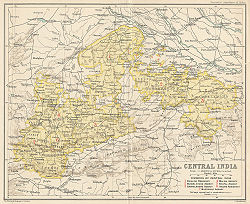Bhopal Agency
| Bhopal Agency | |||||
| Agency of British India | |||||
|
|||||
| Map of the Central India Agency with the Bhopal Agency in its central sector | |||||
| History | |||||
| • | Established | 1818 | |||
| • | Accession to the Indian Union | 1947 | |||
| Area | |||||
| • | 1901 | 30,181 km2(11,653 sq mi) | |||
| Population | |||||
| • | 1901 | 1,157,697 | |||
| Density | 38.4 /km2 (99.3 /sq mi) | ||||
The Bhopal Agency was a section of British India's colonial Central India Agency, a British political unit which managed the relations of the British with a number of autonomous princely states existing outside British India.
The Agency was formed in 1818 at the conclusion of the Third Anglo-Maratha War, and covered the princely states of Bhopal (largest and eponymous), Khilchipur, Kurwai, Narsingarh, Muhammadgarh, Pathari and Rajgarh surrounding Bhopal, as well as the districts of Bhilsa and Isagarh, which belonged to the Gwalior State and also the district of Sironj, which belonged to Tonk State in Rajputana.
The head of the Agency was appointed by the British Governor-General of India. In 1854 the Bhopal Agency became part of the newly created Central India Agency. In 1895 the Gwalior districts of Bhilsa and Isagarh were transferred from Bhopal Agency to Gwalior Residency. In 1931 the princely states of Dewas Senior and Dewas Junior were added to the agency and in 1933 the state of Makrai was transferred from the Central Provinces and Berar.
...
Wikipedia

